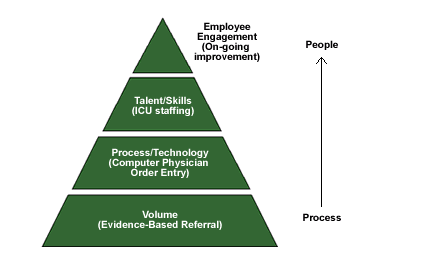A recent Tuesday Briefing article, "Fatal Admissions: Are Patients Safe?" (see Related Items), noted that according to a 2000 Institute of Medicine report, medical errors kill up to 98,000 people annually. Based on Gallup's 2001 patient loyalty data, only 47% of emergency department patients and 50% of inpatients were "very satisfied" with staff making them feel safe and secure. (For a discussion of operating room directors' opinions on patient safety, see "Signs of Life for Confidence in Hospital Care" in Related Items.) How can patient safety be improved?
Gallup Findings
At 171 hospitals, Gallup examined the relationship between employee engagement from 1998-2000 and actual malpractice loss in 2000.

Hospitals scoring in the top quartile in employee satisfaction experienced average safety-related losses that were $700,000 below average for all hospitals tested (see above). Conversely, hospitals in the bottom quartile of employee satisfaction experienced average losses that were nearly $420,000 above the hospital average. This finding indicates that an engaged workforce is one of the major keys to minimizing safety-related loss.
Differing Perspectives on Patient Safety
Six years ago, the American Medical Association (AMA), in partnership with CNA HealthPro, 3M and Schering-Plough Corp, founded the National Patient Safety Foundation (NPSF). NPSF's mission is to bring together various segments of the healthcare industry, including physicians, to improve patient safety. According to the American Medical News, NPSF is seeking to create a "culture of patient safety." As AMA board chair Dr. Timothy J. Flaherty notes in the American Medical News, "Accidents do happen and the best way to handle them is to acknowledge them when they occur, and figure out how not to let them happen again."
The Leapfrog Group, founded in November 2000 by the Business Roundtable, adopts a more process-oriented approach, driven by its purchasing power. Major objectives include treating high-risk conditions only at the best and most experienced hospitals (evidence-based referral), use of computerized prescription systems (computer physician order entry), and staffing intensive care units (ICUs) with specialists trained in critical care.
A More Comprehensive Approach
Gallup's research indicates that patient safety begins with a hospital's employees. Neither the NPSF approach nor the Leapfrog Group approach are right or wrong, but they are both incomplete. The NPSF's "culture of patient safety" is focused primarily on outcomes without accounting for procedural issues that will help to achieve those outcomes. The Leapfrog Group, on the other hand, is focused on process and procedure, but does not address workplace quality and personnel issues. A more comprehensive approach, which integrates Gallup's findings on employee engagement with the other two approaches, is illustrated in the pyramid below.

At the base of the pyramid is volume. Healthcare employees maintain their skills through practice, and volume helps justify technology purchase. Establishing a steady volume of patients is a required foundation of quality care. The Leapfrog Group's concept of "evidence-based referral" is included in this stage of the patient safety pyramid.
The next stage is process and technology, which would include the Leapfrog Group's proposal to implement computer physician order entry. People need the proper materials and equipment in order to protect patients' safety. These first two stages are required to provide the infrastructure foundation to support a workforce. Changes at these levels may achieve improvements in individual outcomes, but cannot drive continued improvement.
Continued improvement begins at stage three -- hiring staff with appropriate talents and providing training for skill development. Leapfrog's effort to staff all ICUs with specialists trained in critical care is part of this stage. The best infrastructure cannot succeed without a talented, high-quality staff.
But even the best staff will not succeed unless properly motivated. The top level of the pyramid is employee engagement; ongoing improvement hinges on creating an engaged workforce. Employees must be engaged in their work in order to maintain the infrastructure described above, all the components of which are needed to promote patient safety.
For more on employee engagement in the healthcare industry, see "Quality vs. Efficiency: Can Hospitals Have Both?" and "Nursing: The Rules of Engagement?" under Related Items at right.